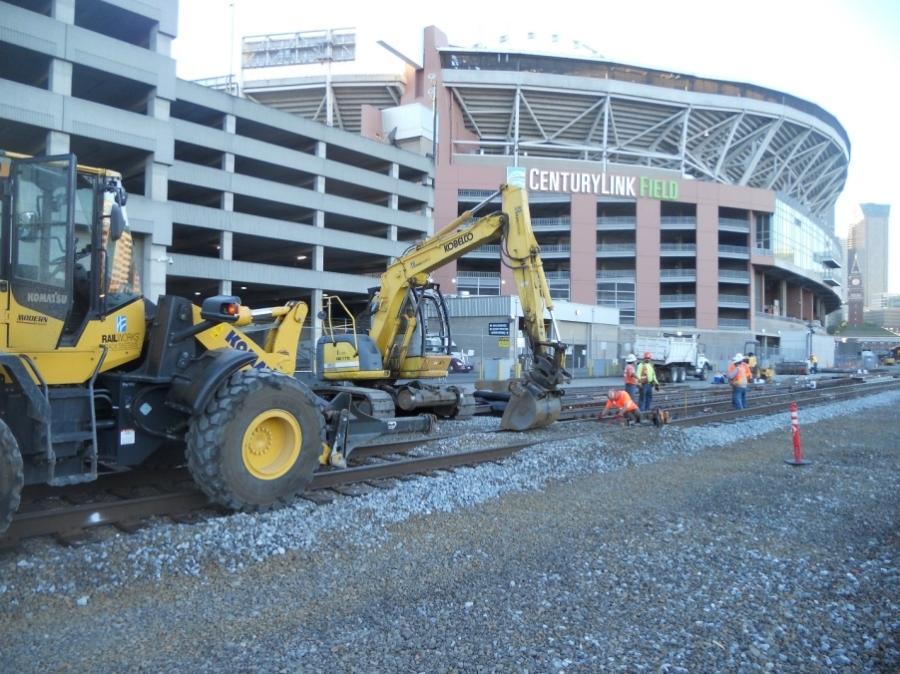The improvements will automate 21 switches that conductors currently must throw by hand.
A Komatsu WA320 wheel loader (foreground) and a Kobelco 175 excavator are two of the workhorses involved in replacing hand-operated switches with automatic switches at King Street Station in Seattle. (WSDOT photo)
Nobody is happier about the improvements under way at the King Street Station than the conductors aboard the trains that stop at the historic Seattle terminal.
The improvements will automate 21 switches that conductors currently must throw by hand. Scattered along 2,000 ft. (609 m) of seven separate tracks, the new switches are part of a $38.5 million Washington State Department of Transportation (WSDOT) project that includes installing new signals and adding a new platform.

Each switch doesn't need to be thrown every time a train pulls in and out of the station. It all depends on which secondary tracks a train uses to reach a platform or the maintenance yard when exiting the main line. While some switches are already automated and some trains can pull directly into some platforms, most switches are not automated, adding minutes to each arrival and departure — and sweat to the brow of conductors as they hop on and off the train.
"As you can imagine, that isn't a very efficient process," said David Smelser, capital program manager for the rail, freight and port division of WSDOT. "The trains can be within sight of the station and it may take up to a half hour to actually get to the platform. When they leave, the same thing [happens] in reverse."
The automated switches will end the long slog. Trains will be able to maintain speed instead of inching their way in and out of the station, Smelser said.

The King Street Station project is one of 20 rail improvements either under construction or already completed as part of the Cascades High-Speed Rail Program, which aims to improve Amtrak Cascades service between Eugene, Ore., and Vancouver, B.C.
The Cascades High-Speed Rail Program is led by WSDOT, which partners with the Oregon Department of Transportation to fund Amtrak Cascades. WSDOT received $800 million from the American Recovery and Reinvestment Act (ARRA) to pay for various improvements to rail infrastructure in Washington. The improvements aim to shorten Amtrak Cascades travel times, increase reliability and add two round trips between Seattle and Portland (for a total of six daily).
The King Street Station project began in March and is scheduled for completion in fall 2017. Amtrak is managing the work with support from the Seattle office of Kennedy/Jenks Consultants under a contract with WSDOT.
RailWorks (New York, N.Y.) is performing the switch work. Burlington Northern Santa Fe Railway (BNSF), which owns the main line and most other tracks, is installing the new signals with support from Herzog Contracting (St. Joseph, Mo.).
Other key players include Service Electrical (Snohomish, Wash.); Heritage Mechanical (Poulsbo, Wash.); and Rebar International (Puyallup, Wash.). More than 100 workers are involved in the overall project, Smelser said.
Built in 1906 by railroad magnate James J. Hill, the King Street Station is on the National Register of Historic Places, but the handsome brick structure with its iconic clock tower is more than a landmark. It's a living, breathing railway hub. Amtrak Cascades, Amtrak Coastal Starlight (to Los Angeles) and Amtrak Empire Builder (to Chicago) all use King Street Station as do Sound Transit commuter trains. BNSF freight trains also rumble through.
Keeping all those the trains rolling means that the switches must be replaced during weekends when closing a track or two won't disrupt service. While the RailWorks crew of 15 can replace some switches overnight, replacing others can take up to three weekends depending on their size, said Marty Lenhart, general superintendent.
Three of the switches are double crossovers that form an "X" pattern, which allows trains to cross from one track to another in any direction. The double crossovers are essentially four switches in one. "There's not very many of those in the world," Lenhart said.
BNSF dispatchers will control the automated switches from a command center in Ft. Worth, Texas, that oversees train movements all over the country.
RailWorks is using a stable of company-owned equipment to remove old track, rebuild the grade, lay new track for the automated switches and finish the grade. The workhorses include a Kobelco 175 excavator; a Jackson 6700 tamper; and a Kershaw 46-2-4 ballast regulator — all able to travel directly on the rail — plus a Komatsu WA320 wheel loader.
The King Street Station sits on reclaimed tideland, which required Granite Construction to take an extra step to construct the new 1,000-ft.-long (604 m) concrete platform.
The soupy soil and the weight of the platform's cantilevered canopy — a whopping 400,000-lbs. (181,436 kg) — required driving 51 piles 65 to 75 ft. (20 to 23 m) deep to support each of the canopy's columns.

Granite Construction rented a Link-Belt 218 HSL lattice boom crawler crane and two pile hammers — a Delmag 30-32 diesel hammer and an APE 150 vibratory hammer — to hoist and drive the piles, said Aaron Wilson, project manager.
The biggest challenge of the King Street Station project may have come before construction began as WSDOT had to make sure a gaggle of stakeholders — Amtrak, BNSF, Sound Transit and the station's owner, the city of Seattle — were on the same page. "There's a lot of fingers in the pie," said Smelser. "Delivering this project is a lot about relationships."
The city of Seattle bought the station building (but not the tracks) from BNSF in 2008 for the nominal fee of $10, then led a $56 million makeover that upgraded mechanical systems, protected the building from earthquakes and restored vintage features — including terrazzo flooring and brass chandeliers — that disappeared during previous modernization work.
The building's transformation continues. The city is developing a plan to turn the station's empty third floor into a cultural center.
Today's top stories























